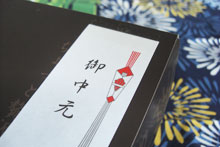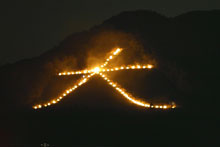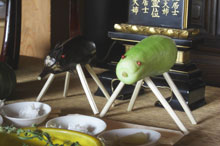Summer in Japan is a season full of festivals and events, and is when many people get a chance to have a weeklong break for overseas traveling or family trips. It is also the time of year, along with the New Year holidays, when people strengthen social and family ties by paying visits to each other or sending gifts. Here we will give a brief description of the three most common summer customs in the Japanese society, Ochugen, Shochumimai / Zanshomimai, and Obon.
Ochugen
 Ochugen (お中元) is a midsummer custom to give gifts to people whom you are close to on a personal or business level. It is a tradition to show one’s appreciation, and is commonly done between relatives who live far, from former students to teachers, company workers to their bosses, or between companies doing business with each other.
Ochugen (お中元) is a midsummer custom to give gifts to people whom you are close to on a personal or business level. It is a tradition to show one’s appreciation, and is commonly done between relatives who live far, from former students to teachers, company workers to their bosses, or between companies doing business with each other.
The content can be pretty much anything, and beginning in early June you will see at many department stores, supermarkets and confection shops special events and reservations for Ochugen. Nowadays online ordering has become common too. While the most standard being western and Japanese confection, alcoholic beverages or fruit juice, the selection ranges to noodles like Somen, meat including ham and sausages, canned seafood, tea and jam, fresh fruit, Nori (dried seaweed) and even cooking oil. As far as food goes, anything is fine. Other than food, towels, bed sheets, soap and detergent are classics. The only things that should be avoided are footwear, stationery and watches, because footwear means “to step on,” and stationery and watches are associated with the idea of “working hard” and is not suitable as a gift to someone superior to you. The average price range is 3,000 Yen to 5,000 Yen, or higher if you are sending it to someone who is particularly important to you.
Shochumimai/Zanshomimai (postcards)
In the same way as sending New Year cards (Nengajo), Japanese people send midsummer greeting cards called Shochumimai (暑中見舞) to friends and relatives. This derives from the custom of caring about each other’s health at the hottest time of year. The cards are normally sent during the period between the end of rainy season (late July) and August 7 (the day before Risshu, the first day of autumn). Cards can be sent after August 8, however the name changes to Zanshomimai. Just like the New Year cards printed by the post office, there are midsummer cards with lottery numbers on them for a draw in which recipients of the cards have a chance to win presents.
Obon holidays
 The 4 days between August 13 and16 are generally known to be the Obon (お盆) period, an important time to respect the spirits of the ancestors. On the 13th, a fire called Mukaebi will be made at each house to welcome the returning of the spirits, and send them back on the 16th with the Okuribi fire.
The 4 days between August 13 and16 are generally known to be the Obon (お盆) period, an important time to respect the spirits of the ancestors. On the 13th, a fire called Mukaebi will be made at each house to welcome the returning of the spirits, and send them back on the 16th with the Okuribi fire.
Although Obon is a nationwide custom, the manners reflect local colors and vary greatly depending on the region. For example, the ritual takes place in July (13-16) in Tokyo. At some places including Kyoto, Okuribi is a big event as seen in the Gozan Okuribi bonfires (aka Daimonji). In some other regions, paper lanterns are sent down the river (Toro-nagashi) instead of making an Okuribi fire.
 There are also places where they put a set of Shoryouma (精霊馬) on the family altar. Shoryouma is usually a pair of a horse and a cow, the horse made with a cucumber and the cow with an eggplant. The horse is for the ancestors’ spirits to arrive home as fast as possible, and the cow is for them to go back at an easy pace.
There are also places where they put a set of Shoryouma (精霊馬) on the family altar. Shoryouma is usually a pair of a horse and a cow, the horse made with a cucumber and the cow with an eggplant. The horse is for the ancestors’ spirits to arrive home as fast as possible, and the cow is for them to go back at an easy pace.
Many businesses close during the Obon period and people take weeklong holidays to get together with families and relatives, visit family graves, or to enjoy domestic and international traveling.
